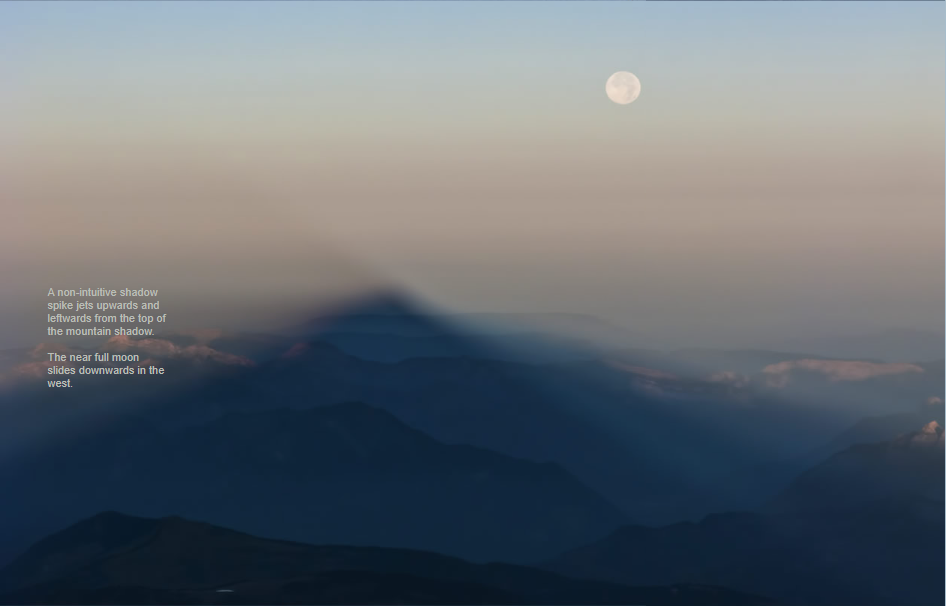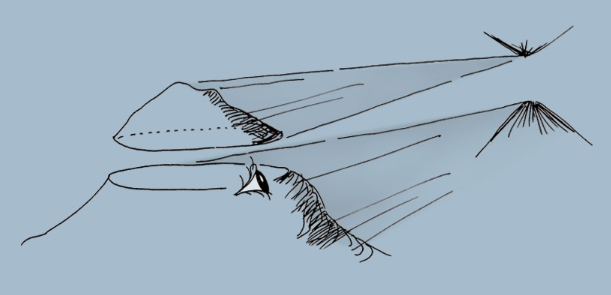Mont Blanc shadow & spike - OPOD
Mont Blanc Shadow & Spike - Exploring Atmospheric Optics Phenomena
Mont Blanc, standing at an impressive 4810 meters, reigns as the highest peak in the Alps. Its majestic presence captivates climbers and photographers alike. One such photographer, Jakub Badelek, captured a stunning image of his fellow climbers, Remek, Tomek, and Lukasz, against the backdrop of Mont Blanc. In this photograph, the freshly risen sun casts a remarkable shadow tube that extends for miles from the mountain towards the antisolar point. The interplay of perspective and atmospheric conditions creates a fascinating triangular apparition in the darkened air.
Unraveling the Enigma of the Shadow Spike
Upon closer examination of Badelek's photograph, an intriguing shadow spike can be observed ascending upwards and to the left from the top of the mountain's shadow. This phenomenon may appear counterintuitive at first glance. Furthermore, the near full moon can be seen descending in the west, adding another element of celestial beauty to the scene.
The Appearance of Shadow Spikes
Shadow spikes, like the one observed in Badelek's photograph, often materialize when climbers find themselves below the summit of a mountain. To better understand this optical illusion, imagine the mountain sliced in two at the climber's level. The lower portion of the mountain casts a long shadow due to the mass of rock beneath it. When viewing this shadow from along its length, it takes on the familiar triangular shape with its point directed upwards.
However, what about the mountain slice above the climber? Surprisingly, it too casts a long shadow tube similar to its lower counterpart. When viewed along its length, this upper shadow also assumes a triangular shape but points downwards. The presence of a stronger spike depends on the orientation of the summit. If the summit is positioned to the right, a more pronounced spike will be visible in that direction. It is akin to perceiving the weighty cloud above the climber as casting anticrepuscular rays.
Factors Influencing the Visibility of Upper Shadow Spikes
To witness a substantial upper shadow spike, climbers must position themselves at a considerable distance below the peak. In Badelek's photograph, he and his companions were approximately 250 meters below the summit, which accounts for the faintness of the spike. The angle of observation and the relative position of the climber in relation to the peak greatly influence the visibility of this optical phenomenon.
The Illusion of Convergence
When viewed from the mountain, the shadow appears almost parallel. However, due to the interplay of perspective, it may seem to converge towards a point. This convergence illusion occurs when the climber looks along the length of the shadow. A simple analogy would be standing in a long corridor, where the geometry produces a similar effect.
Delving Deeper into Atmospheric Optics
The Mont Blanc shadow and spike phenomenon is just one captivating example of atmospheric optics. This field explores the interaction of light with various atmospheric elements, resulting in breathtaking visual displays. Here are some other fascinating atmospheric optics phenomena worth exploring:
- Sundogs: These colorful spots that appear on either side of the sun often accompany cirrus clouds and are caused by the refraction of sunlight through ice crystals.
- Halos: Circular or arc-shaped rings that encircle the sun or moon, halos are created by the refraction, reflection, and dispersion of light by ice crystals or water droplets.
- Rainbows: A classic favorite, rainbows form when sunlight is refracted, reflected, and dispersed by water droplets in the air, creating a spectrum of colors.
- Green Flash: A fleeting burst of green light that can sometimes be observed just as the sun dips below the horizon. It is caused by atmospheric refraction bending different wavelengths of light at different angles.
Conclusion
The Mont Blanc shadow and spike phenomenon, captured by Jakub Badelek, showcases the intriguing interplay of light, perspective, and atmospheric conditions. This optical illusion, where a shadow tube extends from the mountain and appears as a triangular apparition, is enhanced by the presence of an upward and leftward shadow spike. Exploring atmospheric optics phenomena such as this offers us a glimpse into the captivating beauty of our natural world. From sundogs to rainbows, these mesmerizing displays remind us of the wonders that can be found in the skies above.

Mont Blanc Shadow & Spike
Jakub Badelek (photography) took this image of his fellow climbers Remek, Tomek and Lukasz. Mont Blanc at 4810m is the highest of the Alps. The freshly risen sun casts a miles long shadow tube from the mountain towards the antisolar point. Perspective makes the darkened air appear as a triangular apparition. All images ©Jakub Badelek, shown with permission

A non-intuitive shadow spike jets upwards and leftwards from the top of the mountain shadow.
The near full moon slides downwards in the west.

Shadow spikes appear when climbers are below the summit.
Imagine the mountain sliced in two at the climber's level. The mass of rock beneath casts a long shadow. Looking along and through it makes it appear as the 'conventional' triangular mountain shadow with its point upwards.
What about the mountain slice above the climber? It too casts a long shadow tube just like the lower mountain. When the eye looks along it, the upper shadow also has a triangular shape - but pointing downwards. If the summit is to the right then there will be a stronger spike in that direction.
Alternatively, think of the mountain above as a rather weighty cloud casting anticrepuscular rays!
To see a substantial upper shadow spike the climber must be at some distance below the peak. Jakub and his companions were at that point only about 250 m below the summit - hence the faint spike.

The shadow is almost parallel. Perspective makes it appear to converge to a point when it is viewed from the mountain. The climber is then looking along its length.
Imagine standing in a long corridor - the geometry is the same.
Note: this article has been automatically converted from the old site and may not appear as intended. You can find the original article here.
Reference Atmospheric Optics
If you use any of the definitions, information, or data presented on Atmospheric Optics, please copy the link or reference below to properly credit us as the reference source. Thank you!
-
<a href="https://atoptics.co.uk/blog/mont-blanc-shadow-spike-opod/">Mont Blanc shadow & spike - OPOD</a>
-
"Mont Blanc shadow & spike - OPOD". Atmospheric Optics. Accessed on November 26, 2024. https://atoptics.co.uk/blog/mont-blanc-shadow-spike-opod/.
-
"Mont Blanc shadow & spike - OPOD". Atmospheric Optics, https://atoptics.co.uk/blog/mont-blanc-shadow-spike-opod/. Accessed 26 November, 2024
-
Mont Blanc shadow & spike - OPOD. Atmospheric Optics. Retrieved from https://atoptics.co.uk/blog/mont-blanc-shadow-spike-opod/.